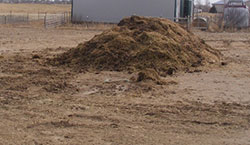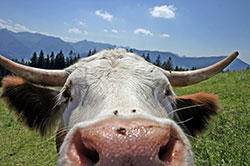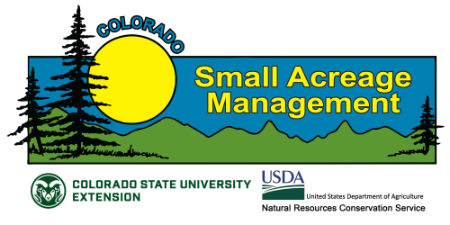Manure Mgmt
Manure Management Guidelines for Small Acreages – educational brochure explains why manage manure properly, best management practices and disposal options for small acreages in Colorado
Healthy Manure Storage Tips

- Divert clean water away from manure:
- Construct berms, terraces or waterways, and/or use downspouts to divert clean water away from corrals and manure storage areas.
- Ensure manure discharge will not enter a water body or leave the property:
- Limit animal access to ponds, streams, ditches, and wetlands.
- Collect manure frequently.
- Stockpile manure at least 100 feet outside a floodplain.
- Do not stockpile manure in a dry creek bed or ditch.
- Protect ground water:
- Locate manure storage piles and livestock corrals at least 150 feet down-gradient from wells.
- Use a 150 foot buffer around wells when land applying manure.
- Reduce nuisances like flies and odor:
- Stockpile manure downwind from barns and 200 feet away from neighbors.
- Plant trees to reduce wind and odor from stockpiles.
- Keep a lid on manure dumpsters.
- Remove manure from corrals and pens every few days to prevent flies, parasites, and worms.
- Cover fresh manure in stockpiles with at least 5 inches of clean bedding, straw, or hay to prevent flies.
- Prevent flies by using pesticides or fly predatory wasps (non-stinging) which can be purchased to manage flies.
Manure Disposal Options
- Dispose off-site to a landfill that accepts manure or hire someone to pick-up and dispose of manure for you.
- Compost manure. This requires the right ratio of carbon (bedding or leaves) and nitrogen (manure). Try 30 carbon to 1 nitrogen by volume. Water to keep the pile 50% moist and aerate the pile regularly.
- Spread manure. Spread in spring or summer. Test manure for nutrient content and spread based on soil test recommendations. This will ensure the nutrients are being utilized by the vegetation growing. Unused nutrients can pollute water bodies and groundwater. Remember that raw manure may contain weed seeds which will be spread back on the land.
- Using manure in gardens? Read Preventing E. coli From Garden to Plate
Estimated Horse Manure Application Rates*
- Dryland range: 1 ton/ac/yr
- Irrigated alfalfa: 5-10 tons/ac/yr
*Test manure for nutrient content and spread based on soil test.
Livestock Mgmt
 Equine Biosecurity
Equine Biosecurity
Biosecurity is often thought of as a problem only for large operations, but there are small practices all horses owners can adopt to keep their animals healthy.
Livestock Management in the Mountains
Booklet developed specifically for Colorado mountain communities. Topics include fencing laws, dealing with predators, cold temperatures and snow, handling emergencies, poisonous plants, and much more.
Targeted Grazing: A natural approach to vegetation management and landscape enhancement
This handbook represents a compilation of the latest research on harnessing livestock to graze targeted vegetation in ways that improve the function and appearance of a wide variety of landscapes. It is organized both as an introduction to targeted grazing for the novice and as a useful reference for seasoned managers.
Livestock/Poultry

Backyard Poultry
- Backyard Chickens overview article
- Home-Produced Chicken Eggs fact sheet
- Custom Meat Processing, Colorado Department of Ag
- Blueprints for Poultry Equipment and Housing Plans
- Poultry Emergency Disease Plan
- Small Scale Poultry – UMN Extension
- Small and Backyard Poultry – eXtension
- Brooding and Rearing Ducklings and Goslings – MU Extension
Sheep and Goats

- Healthy Living with Goats: An overview of health issues for the backyard farmer.
- Raising Sheep & Goats for Profit – 20 min. video. Goat and sheep owners discuss manure and pasture practices, fencing, feed and water, predator control, housing, and treating sick animals.
Animal Emergency Preparedness
- Caring for Livestock Before Disaster – CSU factsheet
- Caring for Livestock During Disaster- CSU factsheet
- Caring for Livestock After Disaster- CSU factsheet
- Community Disaster Animal Planning Toolkit and Saving pets, saving people – 15 min video that provides an overview of the community process of animal disaster planning
- General disaster info at EDEN
Rabies on the Rise in Colorado: Be Aware
- Do not handle wildlife, especially skunks, raccoons, foxes and bats that are acting inappropriately or have died.
- Vaccinate your pets and livestock.
- Educate yourself. Save your life or the life of a loved one. For information go to the Colorado Dept of Health website: www.colorado.gov/cs/Satellite/CDPHE-DCEED/CBON/1251607766329
Resources
Resources & Helpful Information
SAM Webinars and Web Videos
- Alpacas & Llamas: The Sustainable Livestock
- Animal Emergency Preparedness
- Backyard Chickens
- Considerations for Raising Chickens on your Property
- Equine Biosecurity: What can you do?
- Fundamentals of Small Acreage Swine Production
- Livestock Nutrition for Small Acreages
- Non-Structural Carbohydrates in Horses and the Role of Forages
- Planning for a Sustainable Homestead
Guide to Planning on Your Property - Poisonous Plants and Horses
- Poisonous Plants of Colorado
- Raising Sheep and Goats
- Small Scale Cattle Production – Things to Consider
- Temple Grandin – Handling Cattle and Other Livestock
SAM Newsletter Articles
- Picking the Right Chicks for You – spring 2020
- Bird Migration Timing – winter 2020
- Where do Bees go in Winter – winter 2020
- Salmonella Outbreaks Linked to Backyard Poultry – fall 2019
- Rabbit Ownership – summer 2019
- The Relationship of New Spring Grass to Gas And Colic and Nutritional Laminitis in the Horse – spring 2018
- Locoweed Effects on Horses and Livestock – spring 2018
- Tips for Managing Livestock in Winter – winter 2018
- Small Flock Poultry Processing – fall 2017
- Are My Hens Still Laying? – fall 2016
- Backyard Chicken Harvesting – spring 2016
- Is this the Year of Voles? – spring 2016
- Paddock Paradise Track System For Horses – summer 2015
- Rain and Hay Production – summer 2015
- Backyard Poultry Safety – spring 2015
- New Regulations for Small-Scale Producers of Chicken Eggs Focus on Food Safety – spring 2015
- Winter Water for Livestock & Horses
- Western Whorled Milkweed Poisoning in Livestock
- From 4-H Goat Project to Cheesemaking School – fall 2014
- Vesicular Stomatitis In Colorado – fall 2014
- Animal Welfare Approved Label – summer 2014
- Winter Livestock Care – winter 2014
- Healthy Living With Goats – fall 2013
- Hydroponic Fodder Production – spring 2013
- Goats – spring 2013
- Dexter Cattle – winter 2013
- Animal Disease Traceability Rule Released – winter 2013
- Drought Calls for Change in Grazing – winter 2013
- How to Assess Hay for Quality – fall 2012
- High Nitrates in Drought Stressed Forage – fall 2012
- Raising a Pig for Meat – winter 2011
- Brown or White? Let’s Talk Eggs – winter 2011
- Manure: A Renewable Resource – summer 2010
- Backyard Chickens – summer 2010
- Toxic Weeds and Horses – spring 2010
- Feeding Your Horse – spring 2010
- Animal Grazing Habits – winter 2010
- Animal Mortality Planning – summer 2009
CSU Extension Fact Sheets
- Nitrate Poisoning fact sheet
- ATTRA Livestock, beef, dairy, sheep, goats, hogs, and poultry info
- Livestock Factsheets
- National Ag Library: Best single source of research based information on everything Ag
- Poisonous Plants
- Rabies in Horses: Should Horses be Vaccinated in Colorado?
- Stretching Your Horse’s Hay Supply During Drought




